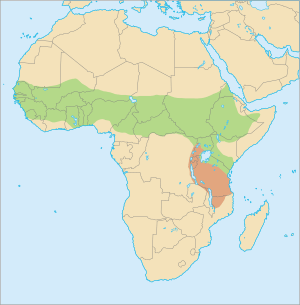Senegal bushbaby facts for kids
Quick facts for kids Senegal bushbaby |
|
|---|---|
 |
|
| Conservation status | |
| Scientific classification | |
| Kingdom: | |
| Class: | |
| Order: | |
| Family: | |
| Genus: | |
| Binomial name | |
| Galago senegalensis É. Geoffroy, 1796
|
|
 |
|
|
Distribution of the Senegal Bushbaby Possible range or accidental records
|
|
The Senegal bushbaby (Galago senegalensis), also known as the Senegal galago or lesser bushbaby, is a small, tree-dwelling primate. These cute animals are active mostly at night, which means they are nocturnal. They live in dry woodlands and savannah areas in Africa.
Contents
What is a Bushbaby?
Bushbabies are small animals that spend their lives in trees. They are part of the primate family, just like monkeys and humans. Because they are active at night, they have very good eyesight and hearing to help them find food and move around in the dark.
Appearance and Size
Senegal bushbabies are quite small. They usually measure about 130 millimeters (about 5 inches) long. They weigh between 95 and 300 grams (about 3 to 10 ounces). Their fur is thick and woolly, and its color can be silvery gray or dark brown. They are excellent jumpers, which helps them move quickly through the trees.
Where Do They Live?
These bushbabies prefer to live in dry woodlands and open savannah regions. They spend most of their time in trees, where they find food and shelter.
At the end of the night, when the sun starts to rise, groups of bushbabies gather together. They use a special call to find each other. Then, they go to sleep in a cozy spot. This might be a nest made of leaves, a group of thick branches, or even a hole inside a tree. They sleep together in groups until night comes again.
Life Cycle and Reproduction
Female Senegal bushbabies usually have one or two babies at a time. The babies grow inside their mother for about 110 to 120 days. This period is called gestation. After this time, the tiny bushbabies are born. They are cared for by their mothers until they are old enough to live on their own.
See also
 In Spanish: Gálago menor para niños
In Spanish: Gálago menor para niños


